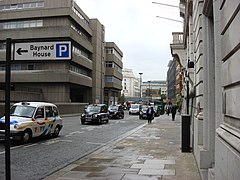Castle Baynard
| Ward of Castle Baynard | |
|---|---|
 | |
 Location within the City | |
| OS grid reference | TQ315811 |
| Sui generis | |
| Administrative area | Greater London |
| Region | |
| Country | England |
| Sovereign state | United Kingdom |
| Post town | LONDON |
| Postcode district | EC4 |
| Dialling code | 020 |
| Police | City of London |
| Fire | London |
| Ambulance | London |
| UK Parliament | |
| London Assembly | |
Castle Baynard is one of the 25 Wards of the City of London, the historic and financial centre of London.
Features
The Ward covers an irregular shaped area, sometimes likened to a tuning fork,[1] bounded on the east by the Wards of Queenhithe and Bread Street; the River Thames to the south; the Ward of Farringdon Without to the north and west; and the Ward of Farringdon Within to the north.
Major landmarks within the Ward include Blackfriars Bridge (the full span of which falls within the City and this Ward), naval establishment HMS President, and St Paul's Cathedral. In addition the area includes the churches of St Bride's, which Poet Laureate Sir John Betjeman described as "magnificent, even by the exalted standards of Sir Christopher Wren",[2] and St. Andrew-by-the-Wardrobe. In former times the Ward also included the Church of St Mary Magdalen Old Fish Street which burned down in 1886 and was not rebuilt[3] and its own charitable foundation, Castle Baynard Ward School.[4] The Mermaid Theatre, on the site of Curriers' Alley[5] and Puddle Dock, nowadays lie within the Ward's catchment area. The north-bank entrance of Blackfriars station, the only London station to span the Thames, also lies within Castle Baynard.
Boundary changes in 2003 expanded the Ward considerably into the traditional area of the two Farringdon Wards, though a small amount of territory was lost to Queenhithe Ward. Today, Castle Baynard is busy and an exceptionally concentrated area of commercial and tourist activity,[6] but still retains its own distinct identity.[7]
History
Castle Baynard derives its name from Baynard's Castle[8] which existed here from the Norman Conquest until it was burnt down during the Great Fire of London in 1666.[9] It was anciently spelled as one word — Castlebaynard — but this is regarded today as incorrect.
Politics
Castle Baynard is one of 25 Wards in the City of London, each electing an Alderman to the Court of Aldermen and Commoners (the City equivalent of a Councillor) to the Court of Common Council of the City of London Corporation. Only electors who are Freemen of the City of London are eligible to stand.
References
- ^ Castle Baynard ward boundaries
- ^ Sovereign City of London Churches, Betjeman,J. : Pitkin, Andover, 1967 (rpnt 1992) ISBN 0-85372-565-9
- ^ Vanished churches of the City of London Huelin, G.: London, Guildhall Library Publishing 1996 ISBN 0-900422-42-4
- ^ Guildhall library records
- ^ Worshipful Company of Curriers
- ^ City Police Overview
- ^ Ward newsletter
- ^ Book 2, Ch. 14-Castle Baynard Ward, in A New History of London: Including Westminster and Southwark: Noorthouck, J. : London, R. Baldwin & Co 1773
- ^ A Dictionary of London, Harben, H.A: Herbert Jenkins,London,1922
External links
- Castle Baynard Ward Club
- Alderman Luder CBE
- www.college-of-arms.gov.uk
- www.curriers.co.uk
- Rev Canon Dr Alison Joyce, Rector of St Bride's
- www.castle-baynard.org.uk
- Map of Early Modern London: Castle Baynard Ward – Historical Map and Encyclopedia of Shakespeare's London (Scholarly)
